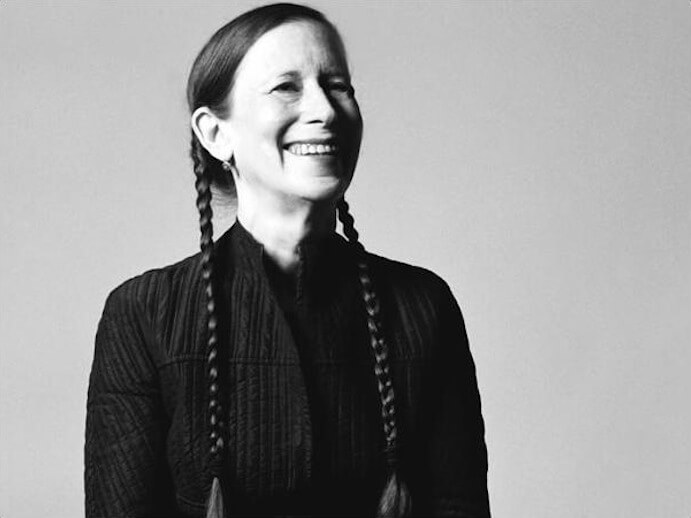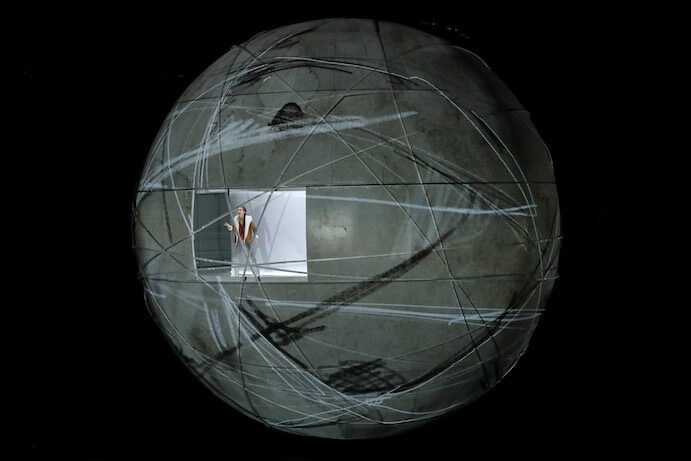On June 11, 12, and 14, 2019, the Los Angeles Philharmonic closed their 2018-2019 centennial season with Meredith Monk’s groundbreaking work, ATLAS: an opera in three parts, at the Walt Disney Concert Hall in Los Angeles. It was the first time 1991 that the opera has been produced.
ATLAS’ narrative isn’t uncommon: it parallels Homer’s Odyssey, or Baum’s The Wizard of Oz, and closely follows Joseph Campell’s stages of the monomyth. By contrast, the unfamiliar and quite radical aspects of the work are found in how Monk’s compositional aesthetic and methodologies advance the fully-realized narrative. Because Monk’s catalog largely fuses wordless vocal music with physical gesture and extended vocal techniques, some who experience her work might be challenged to find the presence of a narrative arc with no libretto to establish or develop the story. However, since audiences are presumably accustomed to the simplicity of the hero’s journey, the departure of Monk’s musical language from that of canonic operatic literature might not seem so strange. In ATLAS, as with much of her other work, Monk combines physical and musical gesture so that a singer’s melodic line might extend from their raised and waving arm, for example. This combination serves the story’s narrative so well that words or sung language would be superfluous.

Meredith Monk–Photo by Peter Ross
No score is available for the 1991 version of ATLAS commissioned by Houston Grand Opera because it doesn’t exactly exist. The singers learned the music and movement en rote taught by Monk herself, and Monk was therefore able to rewrite and tailor some of the composition to the specific performers that she cast in the production. Monk was so ensconced in the opera’s process, start to finish, that producing the work again was perhaps too large or inaccessible an undertaking for another company–until the LA Phil commissioned the updated version to be performed 28 years later.
This 2019 production of ATLAS–directed by the sometimes controversial LA Phil artist-collaborator Yuval Sharon who is closing his three-year residency there–is itself groundbreaking. It marks the first large-scale production of Monk’s work in which she was decidedly not involved in the rehearsal or production process (her involvement here stopped at casting), and so a score was necessary. The score, published by Boosey & Hawkes, is now one of the few in Monk’s catalog, despite her five decades-long career.

Meredith Monk’s ATLAS presented by the Los Angeles Philharmonic–Photo by Mathew Imaging
Sharon and designer Es Devlin conceptualized a spectacular production that was at once simple and full of complex depth, not unlike the opera’s music. The set was primarily a 36-foot diameter globe, a spectacle, seemingly hovering over the stage of Disney Hall. The globe was used as a canvas onto which designer Luke Halls’ projections delimited the characters’ journeys and housed much of the action itself. Under it, the rest of the stage was often set metaphorically as a completely different world of existence.
The extended vocal techniques Monk incorporates–whispers, glottal stops, chirps, almost impossibly wide tessitura, and extremely angular vocal melodies–demand that ATLAS is sung by a specific kind of performer: one with a wholehearted commitment to new things, but who also must have a strong technical foundation and control of their instrument. Further, because of the absence of language and presence of gesture, the work requires its singers to physically embody the music more, and differently, than they might in a traditional opera. On these requirements, this cast of ATLAS largely delivered, marrying Monk’s music with choreographer Danielle Agami’s movement and achieving this difficult task stellarly. Agami’s choreography, while less complex and more accessible than Monk’s 1991 composed movement, did not leave much room for viewer interpretation, for better or worse.
Meredith Monk’s ATLAS presented by the Los Angeles Philharmonic–Photo by Mathew Imaging
The deceptively simple orchestral parts, rife with meter changes and subtle dissonances, were handled with utmost sensitivity by the LA Phil New Music Group, led by a baton-less Paolo Bortolameolli. Particularly notable is the addition of the harp to the work’s slightly expanded re-orchestration, which mirrors the timbre of the performers’ voices gracefully and adds to the fluidity of sonic gesture.
Meredith Monk and Yuval Sharon agreed that this version of ATLAS was meant to be a kind of experiment: could Monk’s works be successful and recreatable entities without her? In the right hands of directors, designers, and musicians, it seems that, yes, it’s possible.

